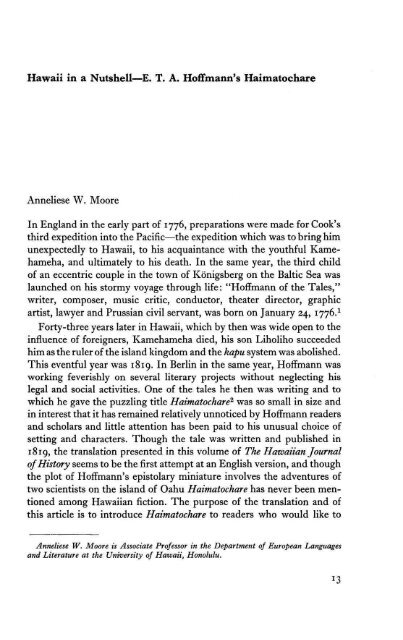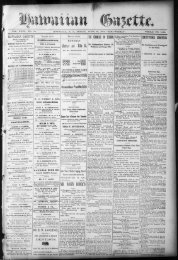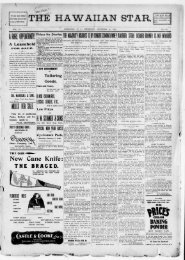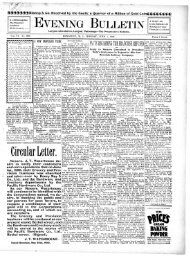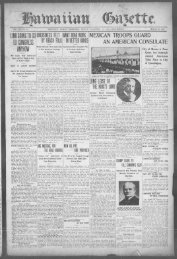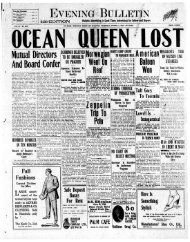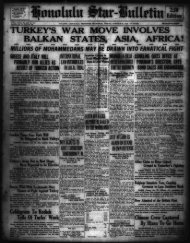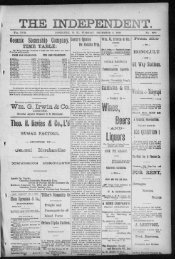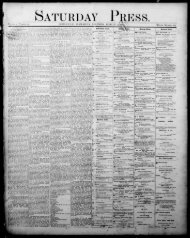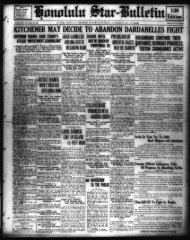Hawaii in a Nutshell—E. T. A. Hoffmann's Haimatochare Anneliese ...
Hawaii in a Nutshell—E. T. A. Hoffmann's Haimatochare Anneliese ...
Hawaii in a Nutshell—E. T. A. Hoffmann's Haimatochare Anneliese ...
Create successful ePaper yourself
Turn your PDF publications into a flip-book with our unique Google optimized e-Paper software.
<strong>Hawaii</strong> <strong>in</strong> a <strong>Nutshell—E</strong>. T. A. <strong>Hoffmann's</strong> <strong>Haimatochare</strong><br />
<strong>Anneliese</strong> W. Moore<br />
In England <strong>in</strong> the early part of 1776, preparations were made for Cook's<br />
third expedition <strong>in</strong>to the Pacific—the expedition which was to br<strong>in</strong>g him<br />
unexpectedly to <strong>Hawaii</strong>, to his acqua<strong>in</strong>tance with the youthful Kamehameha,<br />
and ultimately to his death. In the same year, the third child<br />
of an eccentric couple <strong>in</strong> the town of Konigsberg on the Baltic Sea was<br />
launched on his stormy voyage through life: "Hoffmann of the Tales,"<br />
writer, composer, music critic, conductor, theater director, graphic<br />
artist, lawyer and Prussian civil servant, was born on January 24, 1776. x<br />
Forty-three years later <strong>in</strong> <strong>Hawaii</strong>, which by then was wide open to the<br />
<strong>in</strong>fluence of foreigners, Kamehameha died, his son Liholiho succeeded<br />
him as the ruler of the island k<strong>in</strong>gdom and the kapu system was abolished.<br />
This eventful year was 1819. In Berl<strong>in</strong> <strong>in</strong> the same year, Hoffmann was<br />
work<strong>in</strong>g feverishly on several literary projects without neglect<strong>in</strong>g his<br />
legal and social activities. One of the tales he then was writ<strong>in</strong>g and to<br />
which he gave the puzzl<strong>in</strong>g title <strong>Haimatochare</strong> 2 was so small <strong>in</strong> size and<br />
<strong>in</strong> <strong>in</strong>terest that it has rema<strong>in</strong>ed relatively unnoticed by Hoffmann readers<br />
and scholars and little attention has been paid to his unusual choice of<br />
sett<strong>in</strong>g and characters. Though the tale was written and published <strong>in</strong><br />
1819, the translation presented <strong>in</strong> this volume of The <strong>Hawaii</strong>an Journal<br />
of History seems to be the first attempt at an English version, and though<br />
the plot of <strong>Hoffmann's</strong> epistolary m<strong>in</strong>iature <strong>in</strong>volves the adventures of<br />
two scientists on the island of Oahu <strong>Haimatochare</strong> has never been mentioned<br />
among <strong>Hawaii</strong>an fiction. The purpose of the translation and of<br />
this article is to <strong>in</strong>troduce <strong>Haimatochare</strong> to readers who would like to<br />
<strong>Anneliese</strong> W. Moore is Associate Professor <strong>in</strong> the Department of European Languages<br />
and Literature at the University of <strong>Hawaii</strong>, Honolulu.<br />
l 3
f<strong>in</strong>d out how <strong>Hawaii</strong> got <strong>in</strong>to the works of one of the most fasc<strong>in</strong>at<strong>in</strong>g<br />
writers of the Romantic era <strong>in</strong> Germany.<br />
Ha<strong>in</strong>tatochare is unique <strong>in</strong> its form among <strong>Hoffmann's</strong> works because<br />
it consists exclusively of letters, without any discursive <strong>in</strong>trusion by the<br />
author. As far as the content is concerned, <strong>Hoffmann's</strong> short <strong>in</strong>troductory<br />
address to the reader not only susta<strong>in</strong>s the author's poetic pretense of<br />
authenticity of the letters, it also po<strong>in</strong>ts to the source of his <strong>in</strong>formation,<br />
and <strong>in</strong> addition it <strong>in</strong>vites the historically-m<strong>in</strong>ded reader to compare<br />
<strong>Hoffmann's</strong> fiction with facts related to <strong>Hawaii</strong>an history, though<br />
Hoffmann himself was "somewhat scornful of source-mongers." 3 By<br />
and large these facts were conveyed to Hoffmann by Chamisso, 4 the<br />
botanist and poet who accompanied the second Russian expedition <strong>in</strong>to<br />
the Pacific on the ship Rurik, commanded by Otto von Kotzebue.<br />
Hoffmann met Chamisso <strong>in</strong> the fall of 1814 when the former returned<br />
to Berl<strong>in</strong> to resume his legal career which had been disrupted by the<br />
Napoleonic Wars. In a group of <strong>in</strong>tellectuals and artists they collaborated<br />
on literary projects until Chamisso left on the Rurik expedition <strong>in</strong> 1815.<br />
They resumed their companionship <strong>in</strong> Berl<strong>in</strong> <strong>in</strong> November 1818.<br />
While Chamisso was on the Rurik expedition he spent several weeks <strong>in</strong><br />
<strong>Hawaii</strong> [November 21 to December 14, 1816 and September 27 to<br />
October 14, 1817] but his sojourns never stimulated him to write any<br />
fiction about <strong>Hawaii</strong> or to <strong>in</strong>clude a <strong>Hawaii</strong>an theme <strong>in</strong> his poetry. 5<br />
Immediately after his return from the voyage, however, he completed<br />
a series of scientific essays which were <strong>in</strong>corporated as Bemerkungen und<br />
Ansichten 6 [Remarks and Op<strong>in</strong>ions] <strong>in</strong> the official Rurik expedition<br />
report by Otto von Kotzebue and published <strong>in</strong> 1821. 7<br />
Chamisso enterta<strong>in</strong>ed his circle of friends, Hoffmann among them,<br />
with personal impressions from his voyage, and the extent of his conversations<br />
can be estimated from his Tagebuch [Journal] which, however,<br />
was not published until 1836. 8 Hoffmann, easily stimulated, but factually<br />
oriented and thorough <strong>in</strong> his background research, was <strong>in</strong>trigued by<br />
what he heard from Chamisso and he began to create a fictional voyage<br />
of his own. For this work he made use of Chamisso's documentation,<br />
<strong>in</strong>clud<strong>in</strong>g the botanical and ethnographic collections which he had<br />
brought back from the expedition. Chamisso had also just acquired the<br />
works of several explorers and scientists:<br />
[In London <strong>in</strong> June 1818, Mr. Hunnemann] assisted me <strong>in</strong> the belated acquisition of<br />
all those <strong>in</strong>struments, books and maps which I needed dur<strong>in</strong>g the expedition but which<br />
were not available to me at that time. Thus I became equipped for the way home <strong>in</strong> a<br />
manner <strong>in</strong> which I should have been for the way abroad. 9<br />
With<strong>in</strong> a few weeks after Chamisso's arrival <strong>in</strong> Berl<strong>in</strong>, Hoffmann had<br />
worked out a plan for a new tale and <strong>in</strong> February, 1819, he sent an
outl<strong>in</strong>e to Chamisso about the opuscule which was to become <strong>Haimatochare</strong>.<br />
He also requested numerous details:<br />
Good Morn<strong>in</strong>g,<br />
The story of the louse is supposed to be presented <strong>in</strong> a very short form as a series of<br />
letters.<br />
Conditions:<br />
1. Two naturalists [Englishmen, I suppose] are on a ship which is be<strong>in</strong>g readied for<br />
an expedition [possibly to the South Seas—or have you a different suggestion ?]<br />
2. One of the naturalists f<strong>in</strong>ds an <strong>in</strong>terest<strong>in</strong>g <strong>in</strong>sect by chance on some island. Envy<br />
and hatred of the other! An exchange of letters ensues—challenge—duel—both are killed.<br />
The ma<strong>in</strong> th<strong>in</strong>g is to keep the reader to the last moment <strong>in</strong> the belief that the fight was<br />
over the possession of a young girl, a charm<strong>in</strong>g island beauty. The crucial moment<br />
occurs when the object of the fight is found <strong>in</strong> a cardboard box at the place of the duel.<br />
Consider<strong>in</strong>g these conditions I would like to ask you for the follow<strong>in</strong>g details:<br />
a. What place can be the dest<strong>in</strong>ation of the expedition ?<br />
b. What is the name of the most noteworthy rare <strong>in</strong>sect and on which island will it be<br />
found ? I th<strong>in</strong>k the louse should be of the aphid species—or whatever those little th<strong>in</strong>gs<br />
are called. That is necessary because the naturalist is supposed to make his discovery<br />
<strong>in</strong> the woods <strong>in</strong> the open wilderness. That sett<strong>in</strong>g will motivate a sentimental description<br />
of the moment when he f<strong>in</strong>ds the island girl/creature, and at the end this will resolve<br />
itself <strong>in</strong> a burlesque manner.—It would be marvellous if the name of the <strong>in</strong>sect could<br />
be mistaken for the name of a South Sea island girl, thus <strong>in</strong>creas<strong>in</strong>g the mystification of<br />
the reader.—If you could supply me with a typical name for the ship and with a few<br />
really good English proper names for the characters that would be even better. I need<br />
the names for two naturalists and for the ship's capta<strong>in</strong> who writes the report expla<strong>in</strong><strong>in</strong>g<br />
how his naturalists had been duell<strong>in</strong>g with pistols somewhere near the harbor, how both<br />
were killed and how the unfortunate object of the fight had been lowered <strong>in</strong>to the sea, etc.<br />
Hoffmann<br />
February 28, 1819 10<br />
No written answer by Chamisso to these and other requests from<br />
Hoffmann have been found, but he obviously supplied all the <strong>in</strong>formation<br />
needed, not only based on his own experiences but on those of<br />
earlier voyagers to <strong>Hawaii</strong>. On May 21, 1819, Hoffmann sent his f<strong>in</strong>al<br />
known request for <strong>Haimatochare</strong> materials to Chamisso ask<strong>in</strong>g him for<br />
the "rank and title of the commandant at Port Jackson who ordered the<br />
preparation of the expedition to Oahu and to whom the ship's capta<strong>in</strong><br />
has to address his report." 11 A month later, <strong>in</strong> June 1819, <strong>Haimatochare</strong><br />
was published <strong>in</strong> the periodical Der Freimuthige. 12<br />
Chamisso's Tagebuch gives an <strong>in</strong>sight <strong>in</strong>to the existence of scientists<br />
who went on expeditions to the Pacific and it also sheds light on the<br />
genesis of the rivalry theme <strong>in</strong> <strong>Hoffmann's</strong> <strong>Haimatochare</strong>. First Chamisso<br />
<strong>in</strong>troduces his two colleagues separately and then he contrasts them,<br />
<strong>in</strong>dicat<strong>in</strong>g the deteriorat<strong>in</strong>g morale on board.<br />
In Copenhagen I reported to the capta<strong>in</strong> aboard the Rurik on August 9, 1815. Along<br />
with me came Lieutenant Wormskiold and he too was accepted by Capta<strong>in</strong> von Kotzebue,
apparently because von Kotzebue noticed the great harmony which prevailed between<br />
Wormskiold and myself. 13<br />
On board also was Ivan Ivanovich Eschscholtz, the ship's surgeon who was likewise a<br />
naturalist and entomologist. He was a young doctor from Dorpat, somewhat reserved<br />
but noble and as good as gold. 14<br />
Eschscholtz and I we were able to study, make observations and gather new specimens<br />
<strong>in</strong> complete harmony. There was always an open exchange of materials and ideas<br />
between us. As soon as one had made a discovery he would call the other to witness and<br />
to share. I have to say that it was different with Wormskiold. He preferred, as it is<br />
frequently the case among scientists, a state of envious rivalry to the cooperative relationship<br />
which I had suggested to him and which prevailed between Eschscholtz and myself.<br />
Noth<strong>in</strong>g resembl<strong>in</strong>g the catastrophe depicted <strong>in</strong> <strong>Haimatochare</strong> befell the<br />
rivall<strong>in</strong>g scientists on the Rurik, but Chamisso was frustrated by the<br />
mere presence of Wormskiold.<br />
I remember look<strong>in</strong>g to the desolate bare rocks of Staaten Island [near Cape Horn] and<br />
almost wished to be taken <strong>in</strong> a little boat away from the Rurik and abandoned <strong>in</strong> that<br />
w<strong>in</strong>try isolation just to be relieved of his [Wormskiold's] tortur<strong>in</strong>g presence. 15<br />
Fortunately. Wormskiold left the expedition at St. Peter and Paul,<br />
Kamchatka, before the Rurik headed for <strong>Hawaii</strong>.<br />
Mystification pervades <strong>Haimatochare</strong>'s epistolary fabric, which is<br />
stretched by Hoffmann over both hemispheres from Port Jackson;<br />
Australia, to London, with the center of the action located <strong>in</strong> <strong>Hawaii</strong>.<br />
Hoffmann ma<strong>in</strong>ly wanted to mystify the reader <strong>in</strong> regard to <strong>Haimatochare</strong>'s<br />
identity. But he also modified, of fictionalized, other details<br />
which he came to know through Chamisso, not only for the excitement<br />
of artistic creativity, but for the practical purpose of dispell<strong>in</strong>g similarities<br />
between his fiction and the facts of the Rurik expedition for which<br />
the official report had not yet been published. 16<br />
<strong>Hawaii</strong> had been visited twice by the Rurik. In 1816, the ship came<br />
from California and <strong>in</strong> 1817 from the Aleutian islands. 17 In <strong>Haimatochare</strong><br />
Hoffmann turns the approach to <strong>Hawaii</strong> around by 180 degrees and<br />
makes his scientists arrive from Australia, a cont<strong>in</strong>ent which had not<br />
been visited by the Rurik. Also <strong>in</strong> contrast to the Rurik expedition, which<br />
had orig<strong>in</strong>ated <strong>in</strong> the northern hemisphere at the Russian harbor of<br />
Kronstadt on the Baltic Sea, 18 <strong>Hoffmann's</strong> ship is not on a voyage around<br />
the globe.<br />
Hoffmann changes historical time <strong>in</strong>to fictional time by <strong>in</strong>dicat<strong>in</strong>g only<br />
the day and month on the top of the dated letters and leav<strong>in</strong>g the last<br />
two digits of the year not specified. Thus he achieves vagueness of po<strong>in</strong>t<br />
<strong>in</strong> time—for his contemporary readers the events <strong>in</strong> <strong>Haimatochare</strong> could<br />
have happened at any time between 1800 and 1819—but <strong>in</strong> spite of the<br />
loss of the identify<strong>in</strong>g year the sense of time elaps<strong>in</strong>g is preserved as the<br />
plot unfolds.<br />
16
Through the choice of English names Hoffmann sets "his" expedition<br />
apart from the Rurik's and his selection of names reads like a Who's<br />
Who <strong>in</strong> <strong>Hawaii</strong>an Exploration, yet those names are not commented on <strong>in</strong><br />
Hoffmann editions. His ship "Discovery" 19 br<strong>in</strong>gs to m<strong>in</strong>d the vessel by<br />
the same name that accompanied Cook's Resolution when he unexpectedly<br />
found <strong>Hawaii</strong> <strong>in</strong> 1778. Vancouver, <strong>in</strong> 1792, 1793, and 1794 had also<br />
come on a [different] Discovery to <strong>Hawaii</strong>. Vancouver had been accompanied<br />
by the Chatham under the command of Lieutenant William<br />
Broughton. Hoffmann borrowed, and modified, this officer's name for<br />
one of the rivall<strong>in</strong>g naturalists <strong>in</strong> <strong>Haimatochare</strong>, "A. Brougthon." In<br />
1796, the historical Brougthon returned to <strong>Hawaii</strong> as commander of the<br />
Providence, and as a special <strong>in</strong>cident he described how "K<strong>in</strong>g Kamehameha<br />
visited the ship clad <strong>in</strong> European garments but with a beautiful<br />
yellow feather cloak almost entirely envelop<strong>in</strong>g him." 20<br />
<strong>Hoffmann's</strong> other scientist is named after the botanist on the Vancouver<br />
expedition to <strong>Hawaii</strong>, Archibald Menzies, who did extensive<br />
research <strong>in</strong> the islands and reputedly had a "passion for plants."<br />
Chamisso had an opportunity to <strong>in</strong>spect Menzies' collections <strong>in</strong> London<br />
dur<strong>in</strong>g the layover of the return<strong>in</strong>g Rurik <strong>in</strong> the summer of 1818 and<br />
he wrote about him as follows:<br />
Archibald Menzies, the scientist on the Vancouver expedition made various botanical<br />
excursions onto the mounta<strong>in</strong>s of O-Waihi and Mauwi [<strong>Hawaii</strong> and Maui]. His collections<br />
are, together with many other treasures, still buried <strong>in</strong> Banks' [Sir Joseph Banks']<br />
herbarium. 21<br />
"Bligh", the name which Hoffmann assigns to the capta<strong>in</strong> of his<br />
"Discovery" is based on one of the most colorful men who sailed the<br />
Pacific: William Bligh. He came to <strong>Hawaii</strong> as Cook's sail<strong>in</strong>g master on<br />
the Resolution and <strong>in</strong> 1778 he was chosen capta<strong>in</strong> of the Bounty, where<br />
he became the target of the notorious mut<strong>in</strong>y. 22 Hoffmann names "his"<br />
ship's surgeon, who rushes with "Capta<strong>in</strong> Bligh" to the site of the duel,<br />
"Whidby" after Joseph Whidbey, who had been on many naval assignments<br />
with Vancouver. As master of the Discovery he was with Vancouver<br />
<strong>in</strong> <strong>Hawaii</strong>. 23<br />
Also on board <strong>Hoffmann's</strong> "Discovery" is a "Lieutenant Collnet".<br />
He has a variety of duties. First he jo<strong>in</strong>s the capta<strong>in</strong> and the surgeon on<br />
their sad search for the feud<strong>in</strong>g scientists and at the end he has to<br />
prepare <strong>Haimatochare</strong> for her military funeral. Hoffmann borrows the<br />
name for this officer from Capta<strong>in</strong> James Colnett, who wrote of himself<br />
"I never ceased to blend the zeal of naval character with the spirit of<br />
commercial enterprize [sic]." Capta<strong>in</strong> James Colnett became <strong>in</strong>volved<br />
<strong>in</strong> Spanish-British territorial conflicts <strong>in</strong> the Pacific North-West, traded<br />
furs <strong>in</strong> Ch<strong>in</strong>a and, around 1790, he visited <strong>Hawaii</strong> several times. 24
<strong>Hoffmann's</strong> "First Mate Davis" is the person closest to the rivals and,<br />
later on, to the object of their rivalry, <strong>Haimatochare</strong>. He carries messages<br />
between "Menzies" and "Brougthon", notices their grow<strong>in</strong>g vexation<br />
and alerts the capta<strong>in</strong> of the impend<strong>in</strong>g duel. Then he becomes the<br />
guardian of <strong>Haimatochare</strong>, keep<strong>in</strong>g her <strong>in</strong> his cotton cap until the<br />
governor's decision about her fate arrives from Port Jackson. It may be<br />
assumed that this trustworthy man was named after Isaac Davis, a<br />
British seaman and the sole survivor of the schooner Fair American.<br />
Davis was taken under the protection of Kamehameha and became one<br />
of his first haole advisors. Chamisso mentions him <strong>in</strong> his Bemerkungen. 25<br />
Even the recipient of "Menzies' " expansive letters, "E. [Edward]<br />
Johnstone" <strong>in</strong> London, is treated <strong>in</strong> style by Hoffmann. He seems to be<br />
the namesake of a seafarer to <strong>Hawaii</strong> to whom Chamisso refers as the<br />
"discoverer of the islands WSW of the Sandwich islands <strong>in</strong> 1807",<br />
James Johnstone, Master of the Chatham under Vancouver. 26<br />
Besides the mysterious creature <strong>Haimatochare</strong>, Hoffmann populates<br />
Oahu with a cross-section of <strong>Hawaii</strong>an society: the royal couple, alii<br />
and common folk. However, only the k<strong>in</strong>g and the queen are del<strong>in</strong>eated<br />
as <strong>in</strong>dividuals and have names. While the queen <strong>in</strong> <strong>Haimatochare</strong> bears<br />
the authentic name of the historical "First Lady of <strong>Hawaii</strong>" <strong>in</strong> 1819,<br />
"Kahumanu", her husband is not called Kamehameha as one would<br />
expect. Instead, Hoffmann labels her husband "Teimotu"—a name<br />
which Chamisso uses repeatedly to identify Kaahumanu's brother. 27 The<br />
k<strong>in</strong>g <strong>in</strong> <strong>Haimatochare</strong> plays a very passive role, as a husband and as a<br />
ruler, and he resembles more closely Chamisso's description of Liholiho,<br />
"weak and dull", 28 than Kamehameha, whom Chamisso considered one<br />
of the great men of his time.<br />
<strong>Hoffmann's</strong> lovesick "Kahumanu" who is pursu<strong>in</strong>g "Menzies"<br />
rem<strong>in</strong>ds the reader of those queens to whom Chamisso and Eschscholtz<br />
were <strong>in</strong>troduced <strong>in</strong> a pili-thatched house when they first arrived <strong>in</strong><br />
<strong>Hawaii</strong> <strong>in</strong> November 1816.<br />
They were all stretched out on the smooth ground which was padded with f<strong>in</strong>ely woven<br />
mats. We were urged to take our places among them. Be<strong>in</strong>g new to the islands I felt<br />
quite uncomfortable because of the glance of the queen next to me. When I noticed<br />
that Eschscholtz was quietly try<strong>in</strong>g to get outside I followed him and then I learned<br />
that his queen had expressed herself <strong>in</strong> an even more obvious manner than m<strong>in</strong>e. 29<br />
In the same passage of his Tagebuch Chamisso makes it clear that<br />
Kaahumanu was one of these queens. He <strong>in</strong>dicates that he had read<br />
Vancouver's report about his encounter with the young Kaahumanu<br />
twenty-five years earlier. At that time, Vancouver had stated: "Kaahumanu<br />
appeared to be about sixteen and was one of the f<strong>in</strong>est women we<br />
had yet seen on any of the islands." 30 The illusory <strong>Haimatochare</strong> whom<br />
18
Hoffmann conjures up for his unwary readers seems to be evoked by the<br />
image of such a young Kaahumanu—at least as seen through the eyes<br />
of a European writer of the Romantic era.<br />
The absence of Kamehameha's name as "Kahumanu's" husband<br />
seems to reveal a pattern of avoidance of certa<strong>in</strong> names <strong>in</strong> <strong>Hoffmann's</strong><br />
little story which <strong>in</strong> turn might <strong>in</strong>dicate an understand<strong>in</strong>g, by the author,<br />
of the kapu concept. Kamehameha, Cook and Vancouver, who historically<br />
belong <strong>in</strong> the context of <strong>Haimatochare</strong>, have been left out, while the<br />
names of m<strong>in</strong>or personalities from their entourage were <strong>in</strong>cluded.<br />
Whether this selection of names was decided on by Hoffmann and/or<br />
Chamisso is hard to say—for Chamisso, it was undoubtedly a matter of<br />
respect, especially <strong>in</strong> regard to Kamehameha. "I am proud to have had<br />
the honor of a handshake with three of the great men of the past era—<br />
Kamehameha, Sir Joseph Banks and Lafayette", wrote Chamisso. 31<br />
Though Kamehameha does not appear by name <strong>in</strong> <strong>Haimatochare</strong>,<br />
there is a scene which might have had its orig<strong>in</strong> <strong>in</strong> an <strong>in</strong>cident dur<strong>in</strong>g<br />
Kamehameha's life as a young ruler, as it had been recorded by Vancouver.<br />
In <strong>Hoffmann's</strong> work a scarlet cloak with gold embroidery, a<br />
present which had been sent by the "governor of New South Wales"<br />
along with the schooner, is given to "Kahumanu". This scarlet cloak<br />
makes a deep impression on "Kahumanu" and assumes such a power<br />
over her that she loses her usual serenity and becomes enraptured. Early<br />
<strong>in</strong> the morn<strong>in</strong>g she goes <strong>in</strong>to the most solitary part of the forest and<br />
practices her dances and motions by throw<strong>in</strong>g the cloak <strong>in</strong> this manner<br />
or <strong>in</strong> that on one shoulder or on the other and <strong>in</strong> the even<strong>in</strong>g she enterta<strong>in</strong>s<br />
her court with these presentations.<br />
So far the fiction. Historically, Vancouver describes how Kamehameha<br />
and his court had come aboard the Discovery <strong>in</strong> February, 1793. There<br />
Vancouver had presents ready but Kamehameha undertook the distribution<br />
of these presents himself. Afterwards he received, <strong>in</strong> addition to<br />
what he had gotten before, "a scarlet cloak that reached from his neck<br />
to the ground and was adorned with t<strong>in</strong>sel lace." In the cab<strong>in</strong>, mirrors<br />
were placed opposite each other display<strong>in</strong>g "the whole of his royal<br />
person; this filled him with rapture, and so delighted him that the cab<strong>in</strong><br />
could scarcely conta<strong>in</strong> him." He sent everybody out of the cab<strong>in</strong>, but<br />
soon followed them,<br />
and after strutt<strong>in</strong>g some little time upon deck, he exposed himself <strong>in</strong> the most conspicuous<br />
places, seem<strong>in</strong>gly with the greatest <strong>in</strong>difference, though <strong>in</strong> reality for the sole<br />
purpose of attract<strong>in</strong>g the admiration and the applause of his subjects. 32<br />
The use of an actual event and the shift of the person, from Kamehameha<br />
to "Kahumanu" as wearer of the gift cloak, <strong>in</strong>dicates another<br />
creative modification by Hoffmann. The result serves two purposes: it
captures the mood of the <strong>in</strong>fatuated "Kahumanu" and it presents her<br />
as authentically <strong>Hawaii</strong>an as Hoffmann was able to recreate.<br />
<strong>Hoffmann's</strong> manner of present<strong>in</strong>g the mood of Oahu, the people and<br />
their special cultural traits is closely tied <strong>in</strong> with his <strong>in</strong>tention to create a<br />
poetic illusion which he is go<strong>in</strong>g to destroy at the end. Thus there are<br />
two segments of <strong>Haimatochare</strong>. In the first, while the image of the lovely<br />
maiden named <strong>Haimatochare</strong> is built up, Oahu is an almost perfect<br />
paradise, but with sufficient dark spots to make it an <strong>in</strong>terest<strong>in</strong>g place.<br />
On <strong>Hoffmann's</strong> Oahu visit<strong>in</strong>g naturalists search for hidden marvels,<br />
and <strong>in</strong> lovely glades and deeply shaded groves they spy on <strong>Hawaii</strong>an<br />
beauties. Conveniently all this happens a short distance from the<br />
comforts of the royal court where a benevolent, but slightly obtuse k<strong>in</strong>g<br />
grants his visitors every wish and his queen contributes to their enterta<strong>in</strong>ment.<br />
But the island has its s<strong>in</strong>ister aspect which exists not only <strong>in</strong><br />
"Menzies' " dark premonitions but <strong>in</strong> cruel reality. Friends become<br />
deadly enemies, and not far from the verdant valley there is a desolate<br />
pla<strong>in</strong> between Honolulu and the nearby volcano—an appropriate locale<br />
for a duel at dusk fatal for both combatants and unattended by any<br />
witnesses.<br />
The women whom "Menzies" encounters on this island are of two<br />
different types. He falls for <strong>Haimatochare</strong>, who is young and ethereal,<br />
liv<strong>in</strong>g a very private life on her feather carpet, while "Kahumanu"<br />
pursues him, even <strong>in</strong> public. Hoffmann associates the women with<br />
important <strong>Hawaii</strong>an cultural contributions: "Kahumanu" with the hula<br />
and <strong>Haimatochare</strong>, at least <strong>in</strong>directly, with feather work. Here aga<strong>in</strong>,<br />
the connection with Chamisso's experience <strong>in</strong> <strong>Hawaii</strong> can be surmised.<br />
Chamisso relates two <strong>in</strong>cidents <strong>in</strong> which objects of feather-work art play<br />
a role. In 1816, a party from the Rurik called on K<strong>in</strong>g Kamehameha at<br />
Kealakekua. Dur<strong>in</strong>g the conversation Capta<strong>in</strong> von Kotzebue asked a<br />
favor of the K<strong>in</strong>g: he was eager to obta<strong>in</strong> a feather cloak for Czar<br />
Alexander. Kamehameha consented, had a cloak brought and presented<br />
it to Kotzebue. 33 Chamisso's second memorable encounter with<br />
<strong>Hawaii</strong>an feather-work took place on Oahu. After the meet<strong>in</strong>g with<br />
Kamehameha, the Rurik had sailed to Honolulu where Kalaimoku took<br />
Chamisso as his guest to a heiau dur<strong>in</strong>g a kapu period. At the keiau he<br />
saw and touched a red feather image under circumstances which he<br />
found puzzl<strong>in</strong>g enough to comment twice on them. 34<br />
Accord<strong>in</strong>g to Chamisso's Tagebuch he also witnessed two hula performances<br />
which Kalaimoku had arranged for his visitors. Chamisso<br />
found them superior to the artificiality of contemporary European dance<br />
productions. To show that his judgement was unencumbered by sexual<br />
20
appeal he emphasized his preference for the hula performed by male<br />
dancers. 35 Also <strong>in</strong> order to express his high esteem for the hula he<br />
compared it with the comb<strong>in</strong>ed arts of poetry, music and dance <strong>in</strong><br />
ancient Greece. 36<br />
The second segment of the tale beg<strong>in</strong>s when "Capta<strong>in</strong> Bligh" f<strong>in</strong>ally<br />
<strong>in</strong>troduces the real <strong>Haimatochare</strong> <strong>in</strong> his report to the "governor of New<br />
South Wales." "Bligh's" description of the louse <strong>in</strong> Lat<strong>in</strong> and <strong>in</strong> the<br />
vernacular betrays the hilarious enthusiasm of a neophyte entomologist.<br />
He is an amus<strong>in</strong>g counterpart to the old Dutch lieutenant colonel <strong>in</strong><br />
"Menzies' " first letter to "Johnstone" <strong>in</strong> London. 37 At the revelation<br />
of <strong>Haimatochare</strong>'s true nature, "Davis" is the one who shows practical<br />
experience with such creatures. In this passage Hoffmann aga<strong>in</strong> draws<br />
on Chamisso's anecdotes, though this one is unrelated to Oahu. It<br />
seems that the expedition members became afflicted by lice whenever the<br />
Rurik moved <strong>in</strong>to northern latitudes and they had to resort to a special<br />
o<strong>in</strong>tment concocted by Dr. Eschscholtz. 38<br />
The aspects of <strong>Hawaii</strong>an culture alluded to <strong>in</strong> the first segment of<br />
<strong>Haimatochare</strong>, namely danc<strong>in</strong>g and feather craft, as well as necklaces and<br />
cloaks brought home by collectors <strong>in</strong> the Pacific, are pleas<strong>in</strong>g to the haole<br />
taste. In the second segment, however, the cultural traits of the island<br />
become disturb<strong>in</strong>gly unpleasant. The chant<strong>in</strong>g and wail<strong>in</strong>g by "Kahumanu"<br />
and the other <strong>Hawaii</strong>ans dur<strong>in</strong>g the funeral offends "Capta<strong>in</strong><br />
Bligh's" ear. Only simpler folk, like "Davis," with his cotton cap, can<br />
adjust to the <strong>Hawaii</strong>an ways—he too wails dur<strong>in</strong>g his eulogy for<br />
<strong>Haimatochare</strong> which, <strong>in</strong> turn, <strong>in</strong>duces the <strong>Hawaii</strong>ans to jo<strong>in</strong> him. To<br />
heighten the grotesqueness of the f<strong>in</strong>al scene Hoffmann dwells on the<br />
<strong>Hawaii</strong>an custom of self-mutilation upon the death of an important<br />
person, and through unexpected exaggeration he gives it a typical<br />
Hoffmannesque twist. Instead of knock<strong>in</strong>g out her front teeth as a sign<br />
of bereavement because of "Menzies' " death <strong>in</strong> the duel, "Kahumanu"<br />
uses an enormous shark tooth with which she <strong>in</strong>flicts an enormous<br />
wound onto her enormous buttocks. There is no reference <strong>in</strong> Chamisso<br />
to shark tooth implements or to the tradition of self-mutilation, though<br />
he mentions human sacrifice upon the death of a high chief as a disappear<strong>in</strong>g<br />
custom.<br />
<strong>Hoffmann's</strong> grotesque adaptation of <strong>Hawaii</strong>an traditions could be<br />
considered <strong>in</strong> very bad taste if he were not mak<strong>in</strong>g a mockery of western<br />
customs likewise, especially <strong>in</strong> magnify<strong>in</strong>g the discrepancy between the<br />
ostentatious military funeral and the m<strong>in</strong>uteness of the object committed<br />
to the depth of the ocean. Above all, Hoffmann leaves it up to the reader<br />
to answer the question of which demonstration of mourn<strong>in</strong>g is more<br />
21
misdirected—the "Discovery's" cannon salutes for <strong>Haimatochare</strong> or<br />
"Kahumanu's" wail<strong>in</strong>g for "Menzies."<br />
Chamisso did not m<strong>in</strong>d tell<strong>in</strong>g anecdotes which showed his own<br />
short-com<strong>in</strong>gs and errors, and Hoffmann apparently utilized one of them<br />
for his work. A parallel can be seen between an embarrass<strong>in</strong>g <strong>in</strong>cident<br />
dur<strong>in</strong>g Chamisso's sojourn on Oahu and "Menzies'" decisive moment<br />
on the same island. Just as "Menzies" was look<strong>in</strong>g for a rare lepidopteron<br />
<strong>in</strong> a lovely area near Honolulu, Chamisso had been search<strong>in</strong>g through<br />
the "fertile valley beh<strong>in</strong>d Hana-ruru" for rare botanical specimens.<br />
Fortunately for Chamisso, his "rare f<strong>in</strong>d" which turned out to be<br />
experimentally planted rice, deflated only temporarily his professional<br />
pride and did not lead to a fatal duel, as <strong>in</strong> "Menzies' " case. The<br />
seedl<strong>in</strong>gs which Chamisso had mistaken for some <strong>Hawaii</strong>an herb and<br />
plucked up for his collection belonged to the man from whom he<br />
expected enthusiasm for his unusual discovery, Don Francisco de Paula<br />
Mar<strong>in</strong>, a gentleman-agriculturist who forgave Chamisso for his botanical<br />
error, but he did not forget the <strong>in</strong>cident. 39<br />
Contrary to "Menzies" who got sidetracked on his hunt for butterflies<br />
by the charms of <strong>Haimatochare</strong>, Eschscholtz, Chamisso's congenial<br />
colleague, bagged a new species on Oahu. He described it <strong>in</strong> the Rurik<br />
report as "Vanessa Tameamea from Woahoo. Brown with vermillion<br />
bands and black spots" and <strong>in</strong>dicated that it was named after "Tamaahmaah,<br />
the great hero and first k<strong>in</strong>g of all the Sandwich islands." 40<br />
The bird which is the host, or forms the "feather carpet" for <strong>Haimatochare</strong>,<br />
is specified by Hoffmann as a dove, which would be historically<br />
correct and gives his identification more credence. The <strong>in</strong>troduction<br />
of rock doves to <strong>Hawaii</strong> can be traced back to 1794. The only bird which<br />
Chamisso mentions is an endemic one: "We noticed among landbirds<br />
the Nectar<strong>in</strong>ia cocc<strong>in</strong>ea. Its feathers are highly valued and used for tax<br />
purposes." 41 He probably saw the 'i'iwi.<br />
Though Hoffmann does not specify any plants, he conveys very well<br />
the fact that the forest beh<strong>in</strong>d Honolulu is not a jungle with giant trees.<br />
He differentiates the partly open area <strong>in</strong> the woods where "Menzies"<br />
f<strong>in</strong>ds <strong>Haimatochare</strong> from the very deep, very solitary part which serves<br />
as the practice ground for "Kahumanu's" expressive dances. Aga<strong>in</strong>,<br />
Chamisso's description <strong>in</strong>dicates that the "plant growth mauka of the<br />
coastal pla<strong>in</strong>s is rich but not comparable to the luxuriant growth <strong>in</strong><br />
Brazil." He also dist<strong>in</strong>guishes lighter and darker parts of the forest:<br />
Only low trees follow the contours of the mounta<strong>in</strong>s down the valleys, among them<br />
Aleurites triloba. Their whitish foliage forms bushy clusters at the foot of the mounta<strong>in</strong>s<br />
and on the slopes. But here and there <strong>in</strong> the deep rav<strong>in</strong>es between the mounta<strong>in</strong>s<br />
marvelous banana groves can be found, so dense that stem presses aga<strong>in</strong>st stem and<br />
their leaves create a nocturnal darkness. 42<br />
22
By writ<strong>in</strong>g <strong>Haimatochare</strong> Hoffmann created <strong>in</strong> 1819 a fictional event<br />
which antedated a correspond<strong>in</strong>g event <strong>in</strong> <strong>Hawaii</strong>an history by three<br />
years. The case <strong>in</strong> po<strong>in</strong>t is the delivery of a schooner which had been<br />
repeatedly promised to Kamehameha—for the first time as early as 1794<br />
by Vancouver. The basic <strong>in</strong>formation can be found <strong>in</strong> Chamisso's<br />
Tagebuch.<br />
In 1816 we saw a letter to Tameiameia written by the Pr<strong>in</strong>ce Regent of England <strong>in</strong><br />
which the latter lauded His Majesty's attitude dur<strong>in</strong>g the War of 1812. He thanked<br />
Tameiameia and <strong>in</strong>dicated that <strong>in</strong> addition to the presents which had already been<br />
delivered to him a ship would be sent which the Pr<strong>in</strong>ce Regent had ordered to be built<br />
at Port Jackson. 43<br />
The correspondence referred to by Chamisso has been preserved <strong>in</strong> the<br />
State Archives of <strong>Hawaii</strong>. 44 Historically the long overdue fulfillment of<br />
this promise did not occur until 1822 under the reign of Liholiho. The<br />
British missionary William Ellis described how the schooner was<br />
transported from Port Jackson by the way of Huah<strong>in</strong>e to <strong>Hawaii</strong>:<br />
Tamehameha, who had governed the islands thirty years, and whose decease had taken<br />
place less than twelve months before the arrival of the Missionaries, had <strong>in</strong>variably<br />
rendered the most prompt and acceptable aid to those English vessels which had touched<br />
at the islands. In return for the friendship so uniformly manifested, the British government<br />
<strong>in</strong>structed the governor of New South Wales to order a schooner to be built at<br />
Port Jackson, and sent as a present to the k<strong>in</strong>g of the Sandwich Islands. In the month of<br />
February, 1822, his majesty's colonial cutter Mermaid, hav<strong>in</strong>g <strong>in</strong> charge the vessel<br />
designed for the k<strong>in</strong>g of <strong>Hawaii</strong>, put <strong>in</strong>to the harbour of Huah<strong>in</strong>e for refreshments. The<br />
capta<strong>in</strong> of the Mermaid offered a passage ... to any of the Missionaries who might<br />
wish to visit the Sandwich islands. ... I accompanied the deputation on their visit<br />
to <strong>Hawaii</strong>. . . , 45<br />
In retrospect it is somehow amus<strong>in</strong>g to visualize the fictional passengers<br />
"Brougthon" and "Menzies" and the historical passenger William Ellis<br />
side by side on their way to Honolulu.<br />
Kuykendall summarizes the event <strong>in</strong> the larger context of <strong>Hawaii</strong>an<br />
foreign policy:<br />
The schooner was delivered to Liholiho at Honolulu, May 1, 1822, by Capta<strong>in</strong> J. R.<br />
Kent of the cutter Mermaid, <strong>in</strong> whose care it was brought to <strong>Hawaii</strong>; and on his departure<br />
from the islands a few months later Capta<strong>in</strong> Kent was made the bearer of a letter<br />
<strong>in</strong> which the <strong>Hawaii</strong>an k<strong>in</strong>g thanked the ruler of the British empire for the gift of the<br />
Pr<strong>in</strong>ce Regent, and <strong>in</strong>formed him of the death of Kamehameha and his own succession to<br />
the throne. He added: "The whole of these islands hav<strong>in</strong>g been conquered by my father,<br />
I have succeeded to the government of them, and beg leave to place them all under the<br />
protection of your most excellent Majesty; wish<strong>in</strong>g to observe peace with all nations,<br />
and to be thought worthy the confidence I place <strong>in</strong> your Majesty's wisdom and<br />
judgement." 46<br />
Like Capta<strong>in</strong> Kent, <strong>Hoffmann's</strong> "Capta<strong>in</strong> Bligh" stayed several<br />
months <strong>in</strong> Honolulu "<strong>in</strong> order to strengthen the cordial alliance."<br />
23
A biographical note on the author of <strong>Haimatochare</strong> needs to be <strong>in</strong>serted<br />
at this po<strong>in</strong>t. One June 25, 1822, shortly after the British schooner<br />
Pr<strong>in</strong>ce Regent had been presented to Liholiho <strong>in</strong> Honolulu, E. T. A.<br />
Hoffmann died <strong>in</strong> Berl<strong>in</strong>, paralyzed and <strong>in</strong> great physical discomfort, as<br />
he was prepar<strong>in</strong>g to dictate a passage of yet another tale. 47<br />
In many ways <strong>Haimatochare</strong> is a typical tale of the Romantic era, even<br />
to the po<strong>in</strong>t of its genesis, for the literature of that period is full of works<br />
which were the result of creative collaboration. Also dur<strong>in</strong>g the Romantic<br />
era, the feel<strong>in</strong>g for other cultures developed, and <strong>in</strong> choos<strong>in</strong>g Oahu,<br />
Hoffmann selected a place on the globe more distant than the locale of<br />
any of his other works. More carefully than most writers of his time,<br />
Hoffmann tried to present the local color of Oahu as precisely as<br />
possible, though the forest episodes <strong>in</strong> <strong>Haimatochare</strong> somewhat recall the<br />
Walde<strong>in</strong>samkeit [sylvan solitude] cliche of earlier writ<strong>in</strong>g conventions,<br />
where wanderers searched the woods for the Blaue Blume, the symbolic<br />
blue flower of the early Romantics.<br />
Romantic curiosity which extends beyond the visible, the tangible and<br />
the rational is also present <strong>in</strong> <strong>Haimatochare</strong>. "Menzies" admits to his<br />
friend "Johnstone" that he is driven by forces other than his <strong>in</strong>vestigative<br />
<strong>in</strong>st<strong>in</strong>ct to go on the expedition. Another trait is the Romantic fasc<strong>in</strong>ation<br />
with the power which be<strong>in</strong>gs and objects can assume over certa<strong>in</strong><br />
<strong>in</strong>dividuals: "Menzies" is mesmerized by <strong>Haimatochare</strong>, and "Kahumanu's"<br />
personality is changed not only by "Menzies' " presence but<br />
also by an object, the scarlet cloak which was sent to her as a gift.<br />
Because Hoffmann treats the story with a light touch, he acknowledges<br />
half-heartedly, but tongue <strong>in</strong> cheek, the general predilection of the<br />
Romantics for nocturnal sett<strong>in</strong>gs and moods. The three crucial moments<br />
<strong>in</strong> <strong>Haimatochare</strong> take place exactly between day and night: "Menzies' "<br />
fatal first encounter with <strong>Haimatochare</strong> occurs at sunset, which means at<br />
six o'clock p.m. at the latitude of Honolulu, <strong>in</strong> late December; the duel<br />
of the rivals is set for six p.m., and f<strong>in</strong>ally, <strong>Haimatochare</strong>'s military<br />
funeral starts at six o'clock "sharp."<br />
In addition to the irony that lies <strong>in</strong> the revelation of <strong>Haimatochare</strong>'s<br />
true nature and <strong>in</strong> the grotesqueness created by the unexpectedly<br />
pompous details of the funeral, Hoffmann <strong>in</strong>troduces a number of other<br />
exaggerations which are supposed to create a comical effect. There is<br />
"Brougthon's" "competent" assessment of "Kahumanu's" emotional<br />
depression and the <strong>in</strong>congruency between the "delicate" nature of her<br />
distress and the robust therapy—breakfast<strong>in</strong>g on broiled fish washed<br />
down with g<strong>in</strong> and rum—which "Brougthon" adm<strong>in</strong>isters to her.<br />
The <strong>in</strong>tense preoccupation of the Romantics <strong>in</strong> dual personalities is<br />
also treated as a subject for mirth. Even after her identification through<br />
24
"Capta<strong>in</strong> Bligh's" letter, <strong>Haimatochare</strong> cont<strong>in</strong>ues to live two lives, as an<br />
entomological celebrity <strong>in</strong> her decorative cardboard box and as a pesky<br />
louse <strong>in</strong> the nourish<strong>in</strong>g environment of "Davis' " cotton cap.<br />
<strong>Haimatochare</strong> has been labelled by various critics accord<strong>in</strong>g to its epic<br />
form, its dramatic solution and its size as "an exquisite grotesque," 48<br />
"a humours tale <strong>in</strong> letters," 49 "a satirical tale" 50 and "a small tragically<br />
grotesque epistolary novel." 51 Miss<strong>in</strong>g among its characterizations is the<br />
concept "<strong>Hawaii</strong>an fiction" which Philip K. Ige discusses <strong>in</strong> Paradise<br />
and Melt<strong>in</strong>g Pot. Ige mentions specifically the so-called "retrospective<br />
novels" <strong>in</strong> which "the writers" imag<strong>in</strong>ation and knowledge recreate the<br />
events, the place, the people, and the time" of earlier eras. Then he<br />
cont<strong>in</strong>ues: "By '<strong>Hawaii</strong>an' fiction we mean fiction about <strong>Hawaii</strong> written<br />
by Island residents and non-residents," express<strong>in</strong>g the assumption that<br />
someth<strong>in</strong>g of the place, the people or the spirit of the region about which they write<br />
will be mirrored <strong>in</strong> their creations, whether <strong>in</strong> the romantic or naturalistic or realistic<br />
modes.<br />
In respect to Ige's discussion <strong>Hoffmann's</strong> tale atta<strong>in</strong>s additional <strong>in</strong>terest,<br />
specifically when the follow<strong>in</strong>g statement by him is also taken <strong>in</strong>to<br />
consideration:<br />
S<strong>in</strong>ce the first <strong>Hawaii</strong>an novel was written <strong>in</strong> 1857 there is no contemporary fiction for<br />
the first period, pre-Cook-1820. 52<br />
<strong>Hoffmann's</strong> tale <strong>Haimatochare</strong>, written and published <strong>in</strong> 1819, seems to<br />
fulfill all requirements stipulated by Ige to be classified as <strong>Hawaii</strong>an<br />
fiction and to be considered as the earliest piece of <strong>Hawaii</strong>an fiction.<br />
These criteria would make <strong>Haimatochare</strong> also the only "contemporary"<br />
<strong>Hawaii</strong>an fiction for the pre-Cook to 1820 period.<br />
NOTES<br />
1 <strong>Hoffmann's</strong> given names at birth were Ernst Theodor Wilhelm. Later he substituted<br />
the name Amadeus for Wilhelm <strong>in</strong> homage to Wolfgang Amadeus Mozart—thus the<br />
<strong>in</strong>itials E.T.A. before <strong>Hoffmann's</strong> family name.<br />
2 <strong>Haimatochare</strong>, Greek, specially co<strong>in</strong>ed name, mean<strong>in</strong>g 'the one who enjoys blood.'<br />
3 Harvey W. Hewett-Thayer, Hoffmann: Author of the Tales (Pr<strong>in</strong>ceton, 1948), p. 140.<br />
4 Adelbert von Chamisso (1781-1838) as a writer most famous for his tale about Peter<br />
Schlemihl, the man who sells his shadow without which he is not accepted by society.<br />
5 Chamisso, however, never lost his <strong>in</strong>terest <strong>in</strong> <strong>Hawaii</strong>. He wrote a classic on the<br />
<strong>Hawaii</strong>an language Uber die <strong>Hawaii</strong>sche Sprache (Leipzig, 1837).<br />
6 In this article Chamisso is quoted, and translated, from Adelbert von Chamisso,<br />
Sdtntliche Werke, ed. Adolf Bartel (Leipzig, n.d.). Hereafter cited as Chamisso,<br />
Werke. Vol. III conta<strong>in</strong>s Reise um die Welt 1815-1818, Tagebuch; vol. IV conta<strong>in</strong>s<br />
Reise um die Welt 1815-1818, Bemerkungen und Ansichten.<br />
25
7 Otto von Kotzebue, A Voyage of Discovery . . . 1815 . . . <strong>in</strong> the ship Rurick . . .<br />
(London, 1821). Hereafter cited as Kotzebue, Voyage.<br />
8 Chamisso, Werke, III.<br />
9 Ibid., III, p. 235. In Werke, IV, pp. 176, 178, 179, 187 Chamisso <strong>in</strong>dicates that he<br />
had access to the works of Cook, K<strong>in</strong>g, Vancouver, Menzies, Turnbull, Lisianskoy<br />
on the subject matter of <strong>Hawaii</strong>.<br />
10 E.T.A. Hoffmanns Briefuechsel, ed. Friedrich Schnapp (Mi<strong>in</strong>chen, 1967), pp. 201-<br />
202. Hereafter cited as Hoffmanns Briefwechsel.<br />
11 Ibid., p. zii.<br />
12 Der Freimuthige, publ. by August Kuhn, vol. 16 (1819) No. 125, 127, 129, June 24,<br />
26, 29.<br />
13 Chamisso, Werke, III, p. 17.<br />
14 Ibid., Ill, p. 18.<br />
15 Ibid., Ill, pp. 32-33.<br />
16 Chamisso sent Kotzebue his Bemerkungen und Ansichten <strong>in</strong> 1819, but the whole<br />
report was not published until 1821, and then <strong>in</strong> a form which made Chamisso<br />
quite unhappy.<br />
17 Chamisso, Werke, III, pp. 113 and 186.<br />
18 Ibid., III, p. 11.<br />
19 "Discovery". In order to <strong>in</strong>dicate that a historical name is used fictionally by Hoffmann<br />
it is put <strong>in</strong> quotation marks.<br />
20 Peter H. Buck, Explorers of the Pacific (Honolulu, 1953), pp. 41-46. Hereafter cited<br />
as Buck, Explorers.<br />
21 Chamisso, Werke, IV, p. 179.<br />
22 Buck, Explorers, p. 30.<br />
23 George Vancouver, A voyage to the North Pacific Ocean and Round the World<br />
(London, 1798) v. I, p. XII. Herefater cited as Vancouver, Voyage.<br />
24 James Colnett, A Voyage to the South Atlantic <strong>in</strong>to the Pacific Ocean 1798 (London,<br />
1798), p. I.<br />
25 Chamisso, Werke, IV, p. 192. "In the European cemetery near Honolulu the follow<strong>in</strong>g<br />
simple <strong>in</strong>scription can be found on Mr. Davis' grave: 'The rema<strong>in</strong>s of M. Isac<br />
[sic] Davis who died <strong>in</strong> this Island April 1810 aged 52 years.' "<br />
26 Ibid., IV, p. 193.<br />
27 Ibid,, IV, p. 183.<br />
28 Ibid., IV, p. 183.<br />
29 Ibid., Ill, p. 118.<br />
30 Vancouver, Voyage, II, p. 122.<br />
31 Chamisso, Werke, III, p. 117.<br />
32 Vancouver, Voyage, II, p. 124.<br />
33 Chamisso, Werke, III, p. 119.<br />
34 Ibid., Ill, p. 127; IV, p. 187.<br />
35 Ibid., Ill, p. 128.<br />
36 Ibid., IV, 190.<br />
26
37 The old Dutchman with his entomological obsession seems to be identical with the<br />
author of the book, "Swammerdamm" to which "Menzies" refers <strong>in</strong> the same letter.<br />
Jan Swammerdam (1637-1680) was a Dutch naturalist, brilliant but somewhat<br />
strange. He made comparative studies of <strong>in</strong>sect life stories, and his classifications are<br />
still valid. About thirty of his works were published and Chamisso might have<br />
brought some of them from London. Swammerdam wrote extensively about his work<br />
with lice. Hoffmann apparently became quite <strong>in</strong>trigued by him because he made him<br />
appear, after <strong>Haimatochare</strong>, <strong>in</strong> Die Konigsbraut, 1821, where "Swammerdamm" and<br />
"Loewenhock" are magicians who duel with telescopes, and <strong>in</strong> Meister Floh, 1822.<br />
Information on Swammerdam's life from A. Schierbeek, Jan Swammerdam (Amsterdam,<br />
1967).<br />
38 Chamisso, Werke, IV, p. 185. In his official account of the "Pr<strong>in</strong>cipal sicknesses of<br />
the crew "dur<strong>in</strong>g the three years voyage" (Kotzebue, Voyage) Eschscholtz did not<br />
mention any lice <strong>in</strong>festation.<br />
39 Ibid., III, p. 124; IV, p. 181. Ross H. Gast and Agnes C. Conrad, Don Francisco de<br />
Paula Mar<strong>in</strong> (Honolulu, 1973), p. 60.<br />
40 Kotzebue, Voyage, III, pp. 376-78.<br />
41 Andrew J. Berger, <strong>Hawaii</strong>an Birdlife (Honolulu, 1972), p. 198; Chamisso, Werke,<br />
IV, p. 181.<br />
42 Ibid., IV, p. 180.<br />
43 Ibid., III, p. 189.<br />
44 AH FO & Ex. 1816.<br />
45 William Ellis, Polynesian Researches, <strong>Hawaii</strong> [London], [1842], Repr<strong>in</strong>t (Rutland,<br />
Vermont, 1969), pp. 33-34.<br />
46 Ralph S. Kuykendall, The <strong>Hawaii</strong>an K<strong>in</strong>gdom 1778-1834 (Honolulu, 1968), p. 76.<br />
47 Der Fe<strong>in</strong>d [The Enemy] which was published <strong>in</strong> the fall of 1823 <strong>in</strong> Frauentaschenbuch<br />
fur das Jahr 1824, a literary yearbook.<br />
48 Hoffmanns Briefwechsel, p. 201, footnote 2.<br />
49 Eduard Grisebach, <strong>in</strong>troduction to E.T.A. Hoffmanns Samtliche Werke (Leipzig,<br />
1900), p. LXXIX.<br />
50 Oskar F. Walzel <strong>in</strong> his <strong>in</strong>troduction to Chamissos Werke, vol. 148, Deutsche National<br />
Litteratur, ed. Joseph Kiirschner (Stuttgart, n.d.) Repr<strong>in</strong>t (Tokyo, 1974), p. LXXII.<br />
51 Richard von Schaukal, E. T.A. Hoffmann : Se<strong>in</strong> Werk aus se<strong>in</strong>em Leben (Zurich, 1923),<br />
p. 165.<br />
52 Philip K. Ige, Paradise and Melt<strong>in</strong>g Pot. Thesis, Columbia 1968, p. 39. See also<br />
James Jackson Jarves, Kiana : a tradition of <strong>Hawaii</strong> (Boston, 1857).


